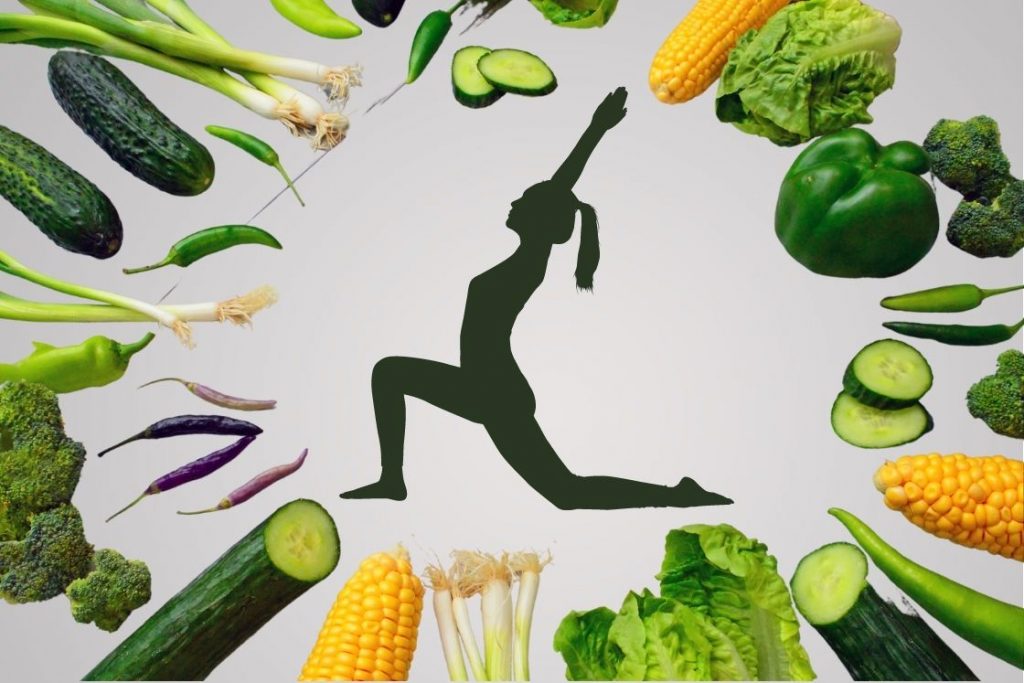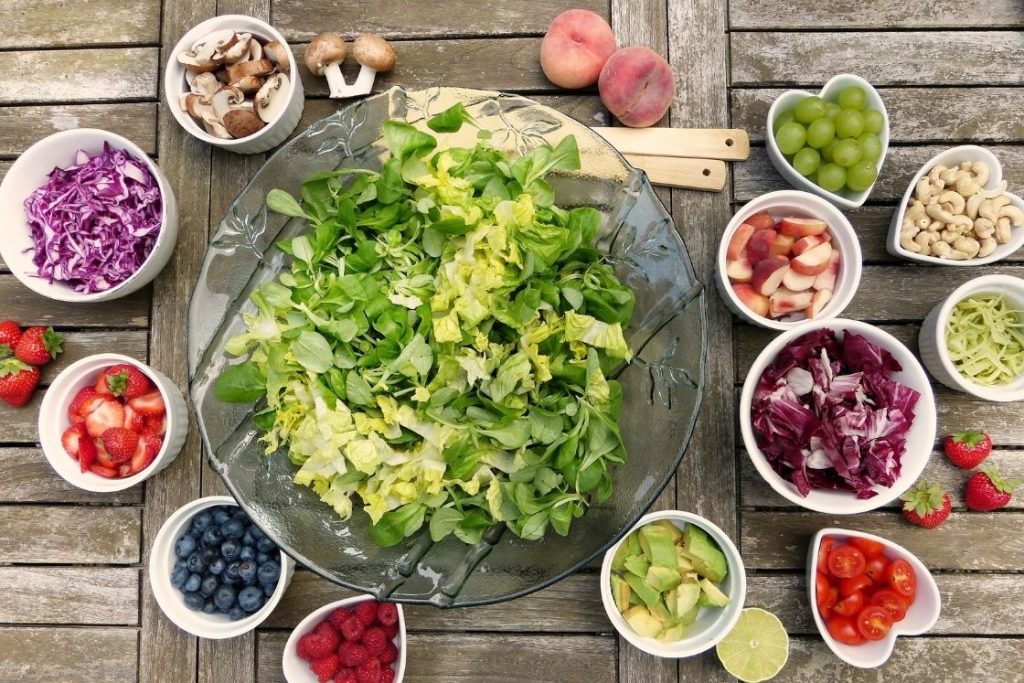
We are what we eat. Food is an essential part and nurturing factor to our growth, shouldn’t we take good care of what and how we eat?
Based on the principles of yoga, yogic diet is an ancient way of eating which increase energy and create balance in the mind and body. It is not only responsible for making our outer body healthy and sound but also works to make our mind balanced and positive. Yogic diet, if followed regularly, aids the meditation process and helps purify the mind and soul of the practitioner.
“By the purity of food, one becomes purified in his inner nature; by the purification of his inner nature, he verily gets the memory of the self; and by attainment of the memory of the self all ties and attachments are severed.” –
Chandogya Upanishad
What is a Yogic Diet?
The yogic diet is comprised of foods with sattvic qualities such as eating whole, unprocessed foods, fresh fruits and vegetables. It follows the yogic principles of Ahimsa and Brahmacharya which emphasize not harming any living being and keeping the physical senses (here, for example, tongue) in moderation. Therefore following vegetarianism is the heart of yogic diet.
The food that yogis consume can be called ‘Lacto-vegetarian’ as it includes mainly milk and plant-based diet. The yogis believed that the yogic food increases Sattva Guna in us.
Just like we Prakriti (nature) humans, foods also can be classified into three Gunas. Based on the after-effects of the food we take, in yoga, we can classify diet into 3 types; sattvic diet, rajasic diet and tamasic diet.
- Sattvic diet – Foods which enhances internal purity and clearity of mind. It includes fresh fruits and vegetables, sprouted grains, roots, tubers, nuts, cow milk, curd, and honey.
- Rajasic diet – Foods which overstimulute our nervous system. Such foods are usually bitter, tart, salty, spicy, hot, and dry. It can include white sugar, radishes, and fried foods.
- Tamasic diet – Foods which promotes dullness, inertia, inactivity, or lethargy. It includes animal meats, liquor, butter onions, mushrooms, stale, medicines and undercooked-and highly fried foods.
However, we should not forget the fact that even if it is called a ‘diet’ it is not limited to ‘what to eat’ or ‘what not’ but also includes the discipline of eating. A yogic diet includes specific rules, schedules, and behavioural eating habits. It’s a must for a yogi to follow these rules. All these dietary rules and regulation aims to maintain a yogic lifestyle. It is the aid for your other spiritual practices, which together keep your body, mind, and spirit healthy and sound.
What to eat and what not?

A yogic diet prescribes what to include in daily food consumption. And it also refrains the practitioners from eating a certain type of food.
Here’s what you can take in a yogic diet
Whole Grains– A yogic diet includes the use of whole grains that increase metabolism as well as help in reducing weight. This includes oats, barley, white or unpolished rice, wheat etc. Whole grains are good to use in breakfast and lunch.
Fruits and Vegetables – Fresh vegetables and fruits are recommended in a yogic diet. They are considered rich in fibre, calcium, and various vitamins that aid physical development. Green and leafy vegetables are recommended in a yogic diet. And it is suggested to eat the fruits that have ripened naturally and not artificially.
Fresh vegetables like brinjals, potatoes, cabbages, spinach, tomatoes, cucumber, pumpkin, cauliflower, lady’s finger and fruits like apples, bananas, grapes, papayas, pomegranates, mangoes, oranges, pears, pineapples, guavas can be included in your daily diet.
Milk and Milk-based Food- Milk, especially cow’s milk is said to be beneficial for the practitioner. It makes the yogi active and energetic as well as provides calcium. Other milk-based food like butter and cheese is also recommended in a yogic diet.
Pure ghee is considered beneficial for the brain and thus has an important place in a sattvic diet. Curd and cream can also be consumed as a part of a yogic diet.
Nuts and Seeds- The practitioner of yoga should include nuts and seeds in a routine diet. They are an excellent source of protein, fibre, vitamins, and minerals. As their fats are not totally absorbed, nuts and seeds aid in controlling body weight as well as food intake.
Dates, sugar candy, green gram, Bengal gram, groundnuts, raisins, pistachios should be included in your daily intake if you are following a yogic diet.
Sprouts- Sprouts are a great source of proteins and nutrients. Thus, they become a part of your yogic diet. Sprouts like peas, soybean, mung bean, and lentils are considered good for a wholesome diet.
Honey- Honey is the source of natural sugar. For this reason, even Ayurveda suggests the use of honey instead of artificial sweeteners. A yogic diet should include the frequent use of honey in meals or breakfasts.
What to avoid?
Stale and Processed Food – A yogic diet prescribes the practitioners to avoid stale or refrigerated food as it has lost most of its quality after being stored. Such kinds of food are not beneficial for health and lead to stomach problems.
A yogic diet also suggests avoiding food that is heated in the microwave as the rays adversely affect the food’s quality and makes it unhealthy. Processed food like canned juices is to be avoided by the practitioner of yoga.
Fried Food- Eating fried food leads to increased levels of cholesterol and blood pressure. Thus, a yogic diet should never include excessive eating of fried food.
Alcohol- Alcohol is considered to be responsible for reversing the effects of yoga. It sidetracks one’s mind from the yogic path and hence should be avoided by the sincere practitioners of a yogic lifestyle.
Caffeine- Caffeine is also considered detrimental to one’s mental development. Excessive consumption of tea, coffee, or any other caffeine substances can lead to distractions and changes in the sleep-wake cycle.
Hence, the use of caffeine should strictly be limited or stopped when you are following a yogic diet.
Meat- Meat increases laziness and inaction. It is also considered as contributing to aggression and anger.
Meat often leads to an increase in uric acid which further leads to diseases like cancer, gout, and skin issues. Hence, the yogic lifestyle asks to give up meat while following a strict diet.
Ways to Follow a Yogic Diet
You might wonder in today’s chips and chunks era; how can it be possible to follow a yogic diet. Well, it is possible if you try to discipline your eating habits according to the following ways.
1. Eat fresh, simple, and healthy
One of the most important habits you would like to inculcate while following a yogic diet is to eat simple and healthy food. Home-made food is preferable as it is filled with more nutrients and love. Try to keep your meal menu simple, one that does not have the use of excessive spices or sweeteners.
You can include seasonal fruits and vegetables in your daily meal. They offer the best nutrients that are needed during that particular season and prepare our body and mind to function better.
Eating fresh is essential for maintaining a yogic diet. Fresh and chemical-free food is good for our mental health as well. You can also go for organic food or homegrown vegetables and fruits.
2. Include a wholesome meal
From your breakfast till dinner, try to make your meals full of wholesome nutrients. Include fruits, green vegetables, sprouts, lentils, and more. Ensure that your meals have appropriate portions of minerals, proteins, carbohydrates, and vitamins.
We need all kinds of nutrients to make our physiology work properly. However, they should be taken in the appropriate quantity. Include all-around meal plans in your routine, which will not just benefit your health but also help progress in your yogic journey.
3. Eat mindfully and with a positive attitude
Take a break from your busy life and sit at your dining table with feelings of gratitude and bliss; completely focus on your sensual awareness and experience of the food. Your attitude while consuming food doubles the effects of the food on the body and mind. That’s why in yogic diet mindful eating has given utmost importance.
Make sure you are munching slowly while eating and thanking mother earth for making this food available to us everyday meals. It is also important to regulate the quantity of the food that you eat. Consume moderate amounts which your body can comfortably digest and do it mindfully.
4. Eat at regular intervals
Yogic diet recommends you regulate your eating habits; it is important that you eat at regular intervals. There should be a gap of at least five hours between your two meals, except for the breakfast. That much of a gap is necessary for the food to successfully digest.
Eat only when you are hungry. The intervals between the meals also ensure this. They help reduce overeating habits and encourage us to eat when our body is signalling hunger. The intervals between meals also result in respect towards food.
Moreover, it is important that you do not eat anything for at least 2 hours after your yoga practice. If you are practising yoga in the evening, ensure that you have eaten at least 4 hours before the practice.
5. Consider fasting at least once a week
Fasting is a recommended practice while following a yogic diet. Fasting refers to abstaining to eat for a certain period, say a day. It benefits to cleanse the body and mind. It is considered a pure way to seek a spiritual goal.
You can consider abstaining from food that takes a little quantity once a week. This will help your body cleanse itself and all the systems are put to work again effectively.
6. Do not harm for your meals
The practice of ahimsa or non-violence is important while you are following a yogic diet routine. It includes avoiding animal protein or eating meat. Animal flesh is generally responsible for producing aggression and inertia. While the aim of yoga is to become sattvic, your dietary discipline should follow ahimsa to help develop the sattvic attitude.
Yoga Diet Sample Menu
If you are determined to start a yogic diet routine but confused about the whats and hows, here is a sample menu that can help you get started;
| Day 1 | Day 2 | Day 3 | |
| Breakfast | Oats, flavored oats | Flavored smoothies, fruit salad | Yoghurt and fresh berries |
| Lunch | Organic tofu curry and rice | Lentil and sweet potato soup | Kale and carrot soup, rice |
| Dinner | Vegetable coconut curry and rice | Rice with coconut milk | Fried vegetables and wholemeal rice |
Benefits of a Yogic Diet
- Maintain overall health & wellbeing – A review article of this year [efn_note] Yogic concept of Diet, Mindful Easting and Fasting http://sajhssjournal.org/Paper/VOL-1_ISSUE-1/SAJHSSV1I1104.pdf [/efn_note] states that therapeutic diet and fasting play a vital role in health and well-being. Moreover, the yogic diet also influences how we think, move, feel, and the quality of our daily life.
- Increased Strength – A 2009 study [efn_note] Traditional methods of food habits and dietary preparations in Ayurveda—the Indian system of medicine https://link.springer.com/article/10.1186/s42779-019-0016-4 [/efn_note] says that a proper use of ingredients in your diet leads to maintaining integrity of the human body, being enriched with physical and mental strength, and growth of nourishment.
- Holistic Lifestyle – Art of Living research [efn_note] A Life in Balance: Sattvic Food and the Art of Living Foundation https://www.mdpi.com/2077-1444/10/1/2/htm [/efn_note] suggests that yogic diet is a means to lead a healthy, holistic, and sustainable lifestyle. It brings harmony among body, mind, and spirit, and thus should be followed by the practitioners of yoga.
- Better Digestion – A 2018 research [efn_note] Influence and intimation of yogic diet over the mind https://www.theyogicjournal.com/pdf/2019/vol4issue1/PartP/5-1-5-610.pdf [/efn_note] states that following a yogic diet that is filled with vital nutrients and clean and fresh ingredients is the food that can be readily digested by our system. And when the food is better digested, it results in less stomach problems and increased energy.
- Psychological Well-being – A 2018 review article [efn_note] Concept of tridosh and manovaha srotas with https://wjpr.s3.ap-south-1.amazonaws.com/article_issue/1546225951.pdf [/efn_note] suggests that the imbalance among the body, mind, and intellect can be caused due to unhealthy lifestyle, especially diet. Following a sattvic routine and adding sattvic diet in your meals can increase mental stability and reduce the chances of developing any psychological disorders.
Final Thoughts
Eating is not merely an enjoyment. It essentially makes us who we are, physically and mentally. Our diet plays a vital role in keeping our well-being at all levels by making our systems function in rhythm.
A yogic diet is undoubtedly the way forward toward a sustainable, healthy, and contented lifestyle. If you are following yoga on your mat and feeling positive about it, try bringing it to your kitchen and in your eating habits too. Let the yogic diet bring you closer to a peaceful lifestyle!





Excellent Information on a Yogic Diet it has given me a lot of answers and on how to lead a better life also a more healthy life.
Thank You.
John Ware